New Study Suggests: The Cosmic Event That Destroyed Sodom
Archaeological excavations at Tall el-Hammam, northeast of the Dead Sea, uncovered massive destruction dating back about 3,650 years. Researchers speculate this could be the biblical city of Sodom, leveled by Hashem as punishment for its sins.
 Dead Sea Area (Photo: Yossi Zamir, Flash 90)
Dead Sea Area (Photo: Yossi Zamir, Flash 90)A new study, published in the scientific journal Nature Scientific Reports, reveals findings from excavations at the Tall el-Hammam site, northeast of the Dead Sea, suggesting unprecedented destruction occurred about 3,650 years ago—known in research circles as the "Middle Bronze Age."
Researchers speculate this site could be the biblical city of Sodom, mentioned in the Book of Genesis as one of the cities of the Jordan Valley destroyed by Hashem as punishment for their sins.
Excavations at the site, located on the Jordanian side of the border, began approximately 16 years ago. In a soil layer dated to around 1650 BCE, researchers discovered anomalous artifacts: melted pottery shards, partially liquefied building materials, and "bubbled" mud bricks, along with charred human bones. This layer of destruction is unique, unlike any archaeological layers studied in the ancient Near East. The findings suggest the city's complete devastation was caused by extremely high temperatures resulting in massive destruction.
Researchers suggest the scale of destruction should be attributed to a cosmic event—a large explosion in the area caused by a meteorite. This unprecedented explosion in intensity completely destroyed all structures in the city, the surrounding walls, and killed thousands of people and animals in the area. Experts compare the explosion's aftermath to the massive destruction caused in June 1908 in Tunguska, Siberia, attributed to an asteroid explosion entering the atmosphere over Russia. The explosion, occurring kilometers above the uninhabited area, resulted in the obliteration of flora and fauna within a radius of approximately 20 kilometers.
No traces of a crater were found on the ground at Tall el-Hammam, indicating an airburst explosion. Evidence of this was found in the metals and minerals within the soil. Among the revealed minerals is distorted quartz, indicative of the high temperature that existed during the explosion, as melting quartz requires temperatures of at least 1,700 degrees.

